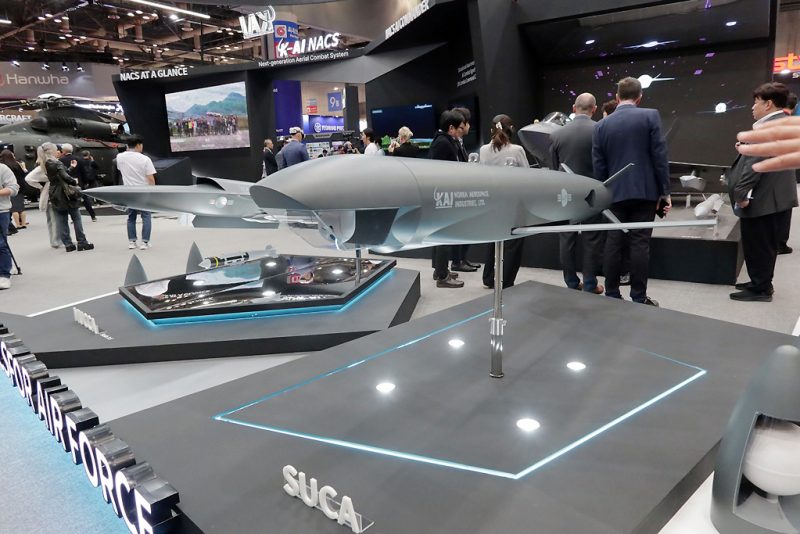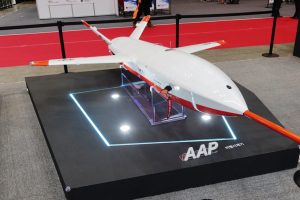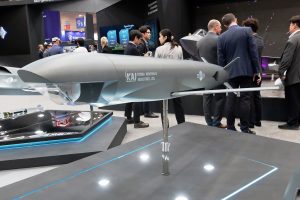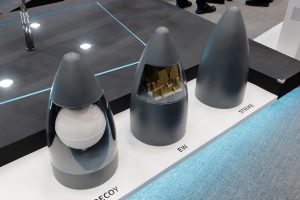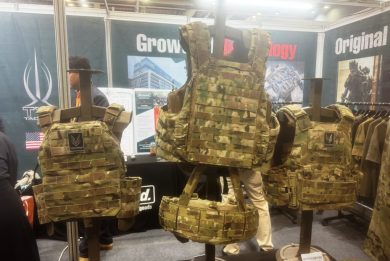ADEX 2025 – Korean Aerospace Industries highlights its K-AI Pilot, an Artificial Intelligence pilot for future UAVs such as the MUCCA and SUCA, currently under development
Replacing the human pilot with an artificial intelligence (AI) one, this is what Korean Aerospace Industries, KAI in short, proposed at the Seoul exhibition, the development of the K-AI Pilot being already flying on the Adaptable Aerial Platform (AAP), the testbed for the new concept. It also showcased its MUCCA and SUCA future UCAVs
A straight upper wing airframe with V rudders and turbojet propulsion, the AAP could be seen flying in the video shown at the exhibition, the K-AI Pilot being able to fly through waypoints, autonomously avoid obstacles, minimising operator’s workload. It is also able to recognise targets, thanks to strong automatic target recognition (ATR) algorithms. A spiral development process is underway, EDR On-Line understood, the virtual pilot learning mission after mission thanks to machine learning, increasing the number of obstacles to be avoided, improving behaviour, and augmenting its ATR capability. A typical example was the detection of a transport-erector-launcher, KIA representatives saying that in time the system will be capable to detect multiple launchers. While currently the K-AI Pilot is flying on a single airframe, KIA is developing the system to allow teamwork, allowing for swarms of autonomous aircraft to perform complex missions. The AAP is the testbed for the K-AI Pilot, KIA exhibiting at ADEX two new unmanned air platforms that are part of the K-AI NACS, for Next-generation Aerial Combat System.
The bigger one is named MUCCA, standing for Medium Unmanned Collaborative Combat Aircraft, an airframe with an aerodynamically shaped fuselage, swept wings and a V-shaped rudder. With a 5,420 kg take-off mass, it is powered by a turbojet providing a 4,100 lb (1,860 kg) thrust, which air intake is located on the upper part of the fuselage and carries up to 545 kg payload. The MUCCA is equipped with an internal weapons bay that allows it maximising range, 500 to 600 nm, speed and stealthness; under each semi-wing two pylons can be fitted to carry externally other weapons, air-to-air and air-to-ground. The MUCCA will operate alongside the KF-21 Boramae or Fighting Hawk, which development should be completed in mis 2026, first deliveries to the Republic of Korea Air Force being expected in late 2026, according to the latest information gathered at ADEX. In the manned-unmanned team (MUM-T) the MUCCA will open the way to manned aircraft, dealing with enemy anti-access/area denial sensors and effectors. Although it is considered an attritable system, the MUCCA will however count on its weaponry to reduce the risks to be neutralised.
Among those we find the SUCA (Small Unmanned Combat Aircraft), a low-cost UCAV which is a close derivative of the AAP. Also powered by a turbojet, which air intakes are visible on the two sides of the fuselage at the back of the airframe, it is tube-launched and can be deployed from land or sea, as well as from the air, a MUCCA being able to carry more than one SUCA. The two swept wigs are hinged in the lower part of the fuselage and are fold backwards when the airframe is in the launch tube, the V-shaped rudder of the AAP being replaced by a cruciform rudder, which short aerodynamic surfaces avoid the need of foldable surfaces.
The payload is installed at the front. Four payloads were proposed, ISR, decoy, electronic warfare, and strike, maximum mass allowed being 20 kg. The intelligence, surveillance and reconnaissance payload was not displayed with the other three alongside the airframe, as it was the one installed, the transparent cover allowing to see the gimballed payload with day/night sensors. The SUCA has a take-off/launch mass of 220 kg, can reach targets at a maximum distance of 300 nm, and can operate in swarms, exploiting the capabilities of the K-AI Pilot.
KAI exhibited a model of a nominal aircraft carrier fitted wit a ski jump, which flight deck was populated by UCAVs and UAVs, a clear indication that the Korean aerospace leading company is working to provide the ROK Navy with carrier-capable unmanned platforms. One of those looked identical to the MUCCA, the main difference being the arresting gear. KAI UAVs might well find their employment on board the Ghost Commander II aircraft carrier proposed by Hanwha in its stand.
Photos by P. Valpolini

